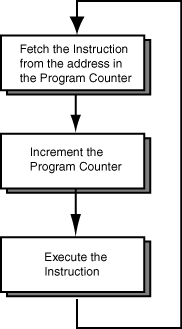(ii) By placing it in a register designated for this purpose.
jal Instruction
The register that is used for linkage is register $31,
which is called $ra by the extended assembler.
It holds the return address for a subroutine.
The instruction that puts the return address into $ra
is (usually) the jal instruction.
Register $31 is one of the two "general purpose registers"
that behave differently from the others.
(The other one is register $0.)
The jal instruction and register $31 provide
the hardware support necessary to elegantly implement subroutines.
To
understand how jal works, review the machine cycle.
The MIPS endlessly cycles through
three basic steps.
Each cycle executes one machine instruction.
The jal instruction does the following
in the execute phase of the machine cycle:
jal sub # $ra ← PC+4 add another 4 to the PC
# This forms the address 8 bytes away from the jal.
# PC ← sub load the PC with the subroutine entry point.
# A branch delay slot follows this instruction.
# After the branch delay the instruction at sub is fetched.
Very Tricky:
the middle step (increment) of the machine cycle has already incremented
the PC by four.
At this point the PC holds the address of the instruction
just after the jal instruction.
Now the execute phase of the jal instruction
adds another four to that address
and puts the result in $ra.
Now $ra holds the address of the second instruction
after the jal instruction.
The correct return address is "address of the jal plus eight".
This is because: (i) returning from the subroutine
to the jal instruction would be a disaster
(since it would execute again, sending control back to the subroutine),
and
(ii) the instruction following the jal
is a branch delay slot.
What instruction is usually placed in the branch delay slot?